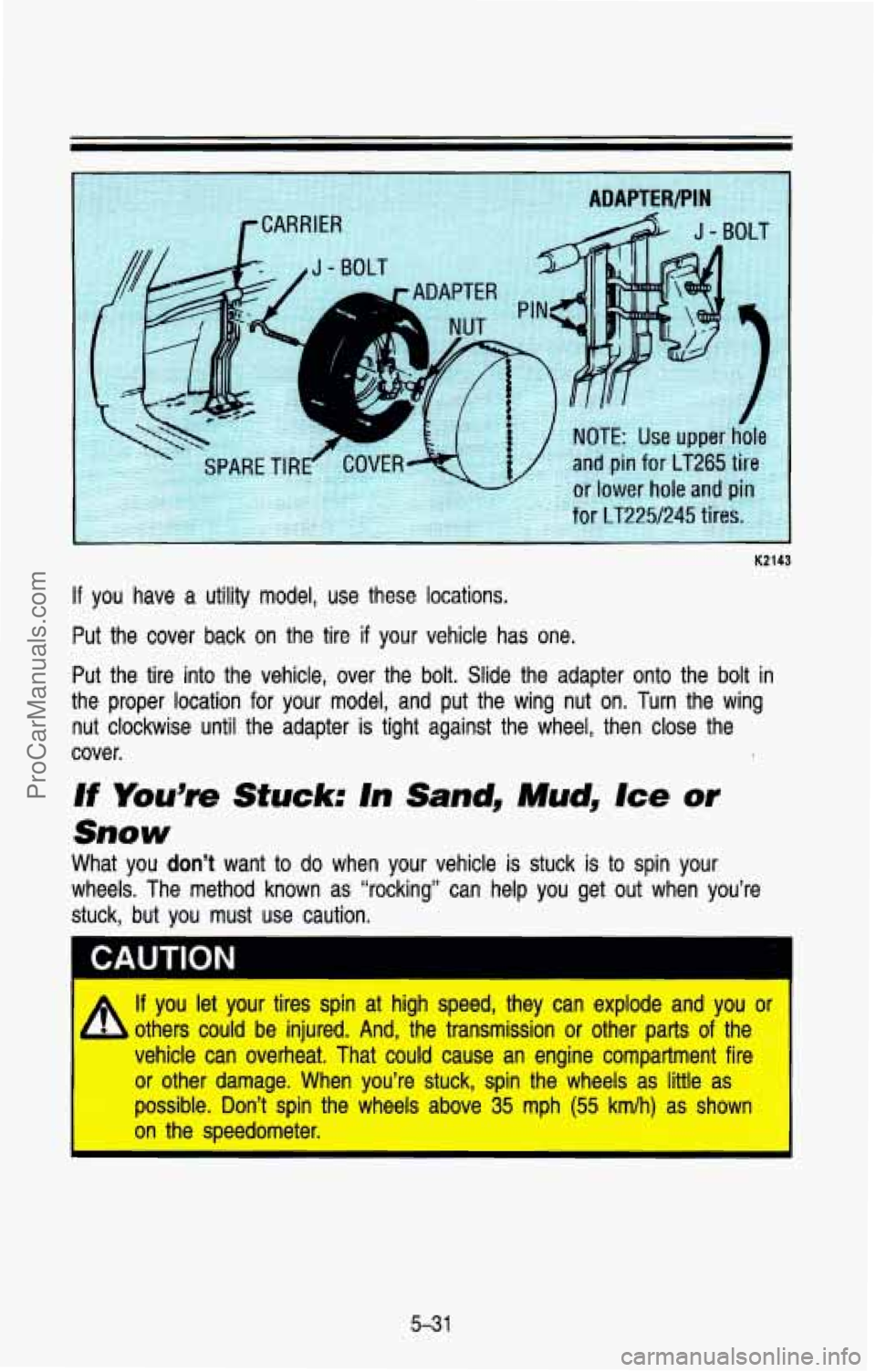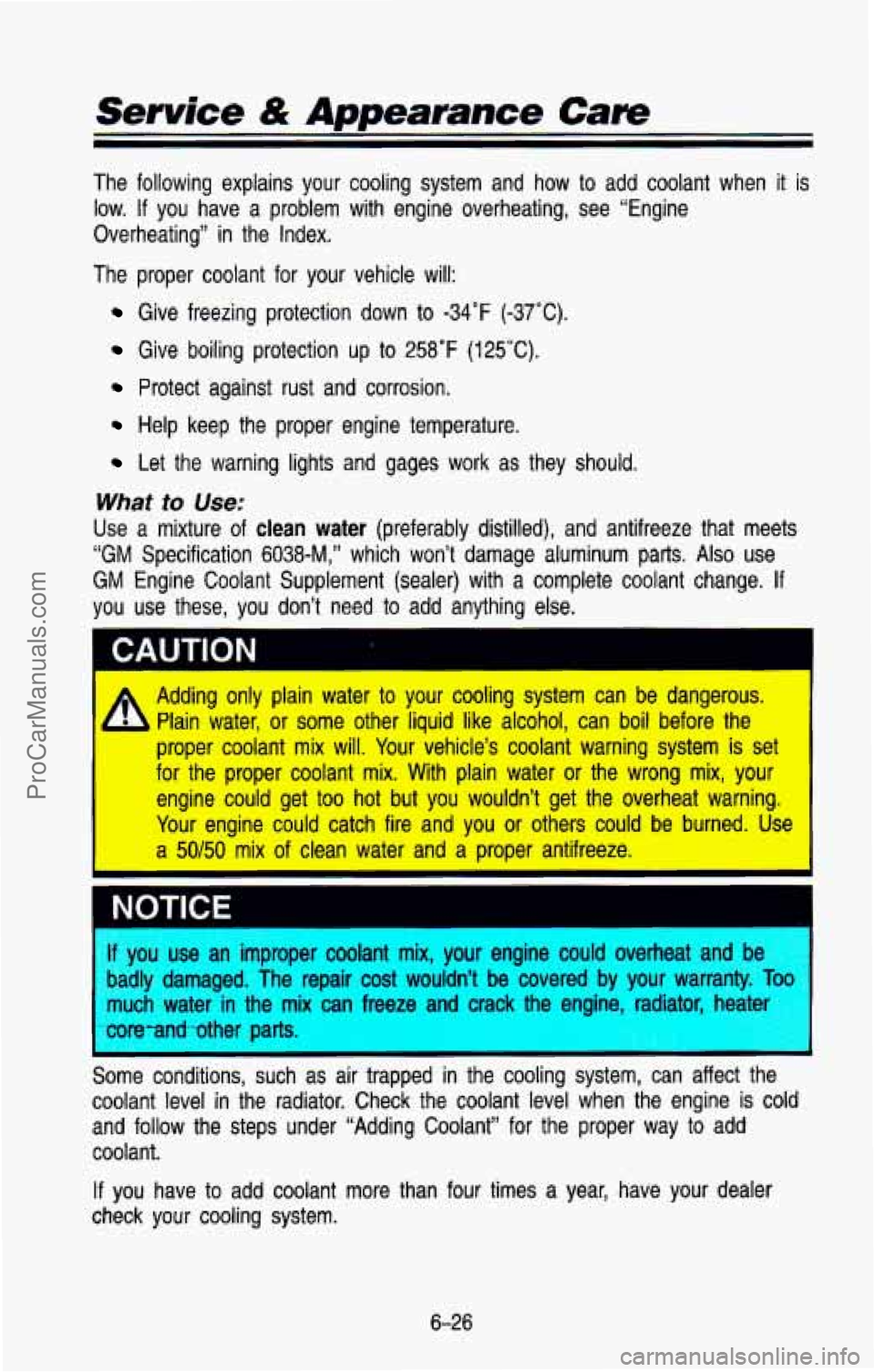1993 CHEVROLET SUBURBAN engine overheat
[x] Cancel search: engine overheatPage 240 of 386

If No Steam Is Coming From Your C gine:
If you get the overheat warning but see or hear no steam, the problem may
not be too serious. Sometimes the engine can get a little too hot when you:
Climb a long hill on a hot day.
Stop after high speed driving.
Idle for long periods in traffic.
Tow a trailer.
If you get the overheat warning with no sign of steam, try this for a minute
or so:
1. If you have an air conditioner, turn it off.
2. Turn on your heater to full hot at the highest fan speed and open the
3. If you’re in a traffic jam, shift to N (Neutral).
window
as necessary.
If you no longer have the overheat warning, you can drive. Just to be safe,
drive slower for about ten minutes.
If the warning doesn’t come back on, you
can drive normally.
If the warning continues, pull over, stop, and park your vehicle right away.
If there’s still no sign of steam, push the accelerator until the engine speed is
about twice as fast as normal idle speed. Bring the engine speed back to
normal idle speed after two or three minutes.
Now see if the warning stops.
But then,
if you still have the warning, TURN OFF THE ENGINE AND GET
EVERYONE
OUT OF THE VEHICLE until it cools down.
You may decide not
to lift the hood but to get service help right away.
5-9
ProCarManuals.com
Page 242 of 386

The coolant level should be at or above COLD. If it isn’t, you may have a
leak in the radiator hoses, heater hoses, radiator, water pump or somewhere
else in the cooling system.
CAUTION
A
Heater and radiator hoses, and other engine parts, can be very\
hot.
Don’t touch them. If you
do, you can be burned.
Don’t run the engine
if there is a leak. If you run the engine, 1‘ it coulc
lose all coolant. That could cause an engine fire, and you could
be
I burned. Get any leak fixed before you drive the vehicle.
I
If there seems to be no leak, check to see if the electric engine fan (if you
have one) is running. If the engine is overheating, the fan \
should be running.
If
it isn’t, your vehicle needs service.
Start the engine again to see
if the regular fan runs when the engine does.
If
it doesn’t, your vehicle needs service. Turn off the engine.
How to Add Coolant to the Coolant Recovery Tank
If you haven’t found a problem yet, but the coolant level \
isn’t at or above
COLD, add a 50150 mixture of clean water (preferably distilled) and a proper
5-1 1
ProCarManuals.com
Page 243 of 386

antifreeze at the coolant recovery tank. (See “Coolant” i\
n the Index for more information about the proper coolant mix.)
Adding only plain water to your cooling system can be dangerou\
s. Plain water,
or some other liquid like alcohol, can boil before the
proper coolant mix will. Your vehicle’s coolant warning system is set
for the proper coolant mix. With plain water
or the wrong mix, your
engine
could get too hot but you wouldn’t get the overheat warning.
Your engine could catch fire and you or others could be burned. Use
a 50150 mix of clean water and a proper antifreeze. I I
NOTICE I
In cold weather, water can freeze and crack the engine. radiator, heater
I core and other parts. Use the recommended coolant.
1
1 ::.
L.
k’
II
PO206
CAUTION
- = -
You can be burned if you spill coolant on hot engine parts. Coolant
contains ethylene glycol
and it will burn if the engine parts are hot
enough. Don’t spill coolant on
a hot engine.
When the coolant in the coolant recovery
is at or above COLD, start your
vehicle.
5-1 2
ProCarManuals.com
Page 262 of 386

K2143
If you have a utility model, use these locations.
Put the cover back on the tire if your vehicle has one.
Put the tire into the vehicle, over the bolt. Slide the adapter onto the bolt in
the proper location for your model, and put the wing nut on. Turn\
the wing
nut clockwise until the adapter is tight against the wheel, then close the
cover.
If You’re Stuck: In Sand, Mud, Ice or
Snow
What you don’t want to do when your vehicle is stuck is to spin your
wheels. The method known as “rocking” can help you get o\
ut when you’re stuck, but you must use caution.
If you let your tires spin at high speed, they can explode and \
you or I
I-, others could be injured. And, the transmission or other parts of the
vehicle can overheat. That could cause an engine compartment fi\
re or other damage. When you’re stuck, spin the wheels as litt\
le as
possible. Don’t spin the wheels above
35 mph (55 kmlh) as shown
on the speedometer.
5-31
ProCarManuals.com
Page 291 of 386

Service & Appearance Care
The following explains your cooling system and how to add cool\
ant when it is
low.
If you have a problem with engine overheating, see “Engine
Overheating” in the Index.
The proper coolant for your vehicle
will:
Give freezing protection down to -34°F (-37°C).
Give boiling protection up to 258°F (125°C).
Protect against rust and corrosion.
Help keep the proper engine temperature.
Let the warning lights and gages work as they should.
What to Use:
Use a mixture of clean water (preferably distilled), and antifreeze that meets
“GM Specification
6038-M,” which won’t damage aluminum parts. Also use
GM Engine Coolant Supplement (sealer) with a complete coolant change.
If
you use these, you don’t need to add anything else.
Adding only plain water to your cooling system can be dangerous.
I
Plain water, or some other liquid like alcohol, can boil before the \
proper coolant mix will. Your vehicle’s coolant warning system is set
for the proper coolant mix. With plain water or the wrong mix, your
engine could get too hot but you wouldn’t get the overheat \
warning. Your engine could catch fire and you or others could be burned. Us\
e
a 50/50 mix of clean water and a proper antifreeze.
jIi ,yo.w use an improper coolant mix, your engine .coutd overheat andi
badly damaged. The repair cost wouldn’t be covered by your warranty.’ TP~
much water in ;the mix can freeze and crack the engine, radiator, .heater
wre-ad -.other parts.
Some conditions, such as air trapped in the cooling system, can affect the
coolant level in the radiator. Check the coolant level when th\
e engine is cold
and follow the steps under “Adding Coolant” for the prope\
r way to
add
coolant.
.. .. ..
If you have to add coolant mdre than four times a year, have your dealer
check
your cooling system.
6-26
ProCarManuals.com
Page 293 of 386

Service & Appearance Care
Radiator Pressure Cap
I
I
-
- K2515
1 NOTICE
four radiator pressure cap is a 15 psi (105 kPa) pressure-type cap and
nust be tightly installed to prevent coolant loss and possible engine
mage from overheating. Be sure the arrows on the cap line up \
with
werffow tube
on the radiator filler neck.
-m recommended.
I
Thermostat
Engine coolant temperature is controlled by a thermostat in the engine coolant
system. The thermostat stops the
flow of coolant through the radiator until the
coolant reaches a preset temperature.
When you replace
your thermostat, an AC@ thermostat is recommended.
6-28
ProCarManuals.com
Page 378 of 386

Skidding ..................................... 4-23
Stuck
in Deep Snow .... 4-56, 5-31
Through Water
............... 2-1 5, 4-34
Uphill
.......................................... 4-28
Winter
........................................ 4-53
With a Trailer
............................ 4-60
Drunken Driving
........................... 4-1 0
E
Electrical System ......................... 6-37
Add-on Equipment
................... 6-67
Engine
Adding Coolant
... 5-1 1, 5-13, 6-27
Air Cleaner
................................ 6-1 6
Block Heater
.......... 2-16, 3-5, 6-16
Computer Command Control
System
..................................... 6-45
Coolant
............................ 6-25, 6-68
Coolant Temperature Gage
...... 2-77
Cooling System
......................... 5-10
Crankcase .................................. 6-69
Exhaust
..................................... 2-28
Fan Noise
.................................. 5-1 6
Identification
................... 6-65, 6-68
Leaving Vehicle While Running
....................... 2-26
Oil (See
“Oil”)
Overheating ................................. 5-8
Running While Parked
............. 2-29
Starting
...................................... 2-1 4
Equipment, Add-on
...................... 6-48
Exhaust System
........................... 6-45
F
Fan Noise ...................................... 5-1 6
Filter Replacement Chart
............ 6-69
Finish
Care
............................................ 6-61
Damage
..................................... 6-62
Automatic Transmission
........... 6-17
Brake
.......................................... 6-32
Fluid Capacities
.................................. 6-68
Coolant
....................................... 5-11
Front Axle ................................. 6-24
Hydraulic
Clutch ....................... 6-21
Leak Check
............................... 6-35
Manual Transmission
............... 6-20
Power Steering
......................... 6-29
Radiator
..................................... 5-13
Rear Axle
.................................. 6-24
Recommended Fluids
.............. 7-25
Transfer Case
............................ 6-23
Windshield Washer
........ 2-40, 6-31
Four-wheel Drive
............... 2-30, 6-23
Transfer Case
................. 2-30, 6-23
Front Axle
..................................... 6-24
Fuel
.................................................. 6-4
Filling Your Tank
......................... 6-6
Foreign Countries
....................... 6-6
Gage
.......................................... 2-76
Gasolines
for Cleaner Air ......... 6-5
Tank Capacity
........................... 6-69
Fuses and Circuit Breakers
.......... 6-43
Fuse Block
................................ 6-44
Headlights
................................. 6-43
Power Windows and
Other Power Options
........... 6-44
Trailer Wiring Harness
............. 6-44
Windshield Wipers
................... 6-44
G
Gages .................................. 2-66, 2-76
Coolant Temperature Gage
..... 2-77
Fuel Gage
.................................. 2-76
Odometer
................................... 2-66
Oil Pressure Gage
.................... 2-78
Speedometer
............................. 2-66
Tachometer
................................ 2-67
Trip Odometer
........................... 2-67
Voltmeter
................. ................. 2-79
Glove Box
..................................... 2-56
9-3
ProCarManuals.com